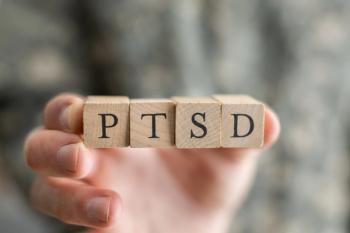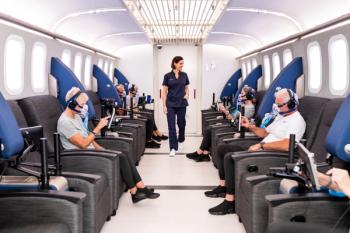
Processes and Interventions That Drive Improvement in PTSD
Here are 5 processes to provide focus and empowerment for patients with PTSD.
“Mike,” a 49-year-old production packer, was injured on the job, suffering extensive third-degree burns on his right hand. He recalls in detail the machine coming down on his hand and the smell of burning flesh.
Posttraumatic stress disorder (PTSD), as defined in DSM-5-TR, is characterized by 5 symptoms, the last 4 of which last longer than a month and cause significant distress:
- Exposure to trauma: experiencing, witnessing, or having repeated exposure to the details of actual or threatened death, injury, or sexual violence—even learning that the traumatic event occurred to a close friend or family member
- Intrusive symptoms: memories, flashbacks, dissociation, psychological distress, and/or physical distress
- Avoidance: trying not to think about the event; avoiding places that remind one of the event
- Negative alterations in thought and mood: amnesia, negative beliefs, distorted cognitions, lack of interest, detachment, estrangement from others, and/or inability to experience positive emotions
- Arousal: irritability, angry outbursts, reckless behavior, hypervigilance, exaggerated startle, difficulty concentrating, and/or insomnia
One of the core features of PTSD is the inaccurate or unhelpful meanings that individuals ascribe to their symptoms. Core beliefs relating to being helpless, weak, or out-of-control become activated, leading to intense negative emotion. Mike begins to use alcohol to help him avoid the experience of that emotion. He is also hypervigilant for danger. He gives up cooking, which he previously enjoyed.
When Mike came to therapy, there were several places to begin working. A recent article by Wiedemann and colleagues1 explored how targeting various points of intervention can relieve the symptoms of PTSD. The study tracked 343 patients for 10 weeks of therapy and demonstrated that changes in these beliefs, experiences, and behaviors (processes) predicted improvement in PTSD symptoms.
Using Latent Change Score Models and weekly measures2-6 to determine causality across time, they demonstrated 5 processes (identified, assessed, and targeted by Clark and Ehlers7) that predicted improvement in PTSD. Here is how these beliefs and behaviors manifested for Mike.
- Negative appraisals: Improvement in these negative beliefs predicted improvement in PTSD.
- “My reactions since being burned mean that I am losing my mind.”
- “I feel different from other people because of my experience.”
- “If I think about this, I will not be able to handle it.”
- “I cannot accept the way my hand has looked since the accident.”
- “I have to be careful because you never know what might happen.”
- Disorganized recall: Improvement in memory predicted improvement in PTSD, but only in the first 5 sessions.
- “I feel my memory about this is incomplete.”
- “My memory of the worst, the pain and smell, feels disconnected from everything else.”
- “It is frozen in time when I am reminded of this; it is hard to remember what happened before and after.”
- Flashback characteristics: Improvement in the frequency, intensity, and immediacy of these intrusions predicted improvement in PTSD throughout therapy.
- “They are like these sudden, unwelcome visitors that crash into my mind almost every day since the accident.”
- “I hate it; it is as if I am right back in that moment, reliving the pain all over again.”
- “Anything burning can trigger it; that one moment dominates and controls my mind.”
- Unhelpful responses: Improvement in unhelpful responses predicted improvement in PTSD throughout therapy.
- “I want to stay home and push this out of my mind.”
- “I cannot cook or do anything; I will just put on some music to drown out my thoughts.”
- “I dwell on what I should have done differently.”
- “I stay away from people and drift off into a world of my own.”
- Safety behaviors: Improvement in these behaviors predicted improvement in PTSD.
- “I try my best to hide my hand; I do not want anyone to see it.”
- “I take precautions whatever I do.”
- “I make extra efforts to make sure everything is safe.”
- “I check closely what is going on around me.”
The study showed the causality was, for the most part, one-way: Improvement in PTSD symptoms did not precede improvements in negative appraisals, flashbacks, unhelpful responses, or safety behaviors. The exception was disorganized recall: Improvement in PTSD did precede further improvement in recall. Assessing and targeting patients’ unhelpful PTSD-related processes led to improvement in PTSD symptoms. Clinically, these processes indicate where interventions are needed:
- Negative appraisals: Mike can assess the evidence that he is losing his mind and generate alternatives.
- “Being reactive could be seen as evidence of me losing my mind, or it could be an automatic survival instinct arising from an extraordinary situation. As I realize that I am safe, my body will begin to react less strongly.”
- Disorganized recall: Mike can update his memory of the accident to fill in the gaps and correct the meaning.
- “By telling my story, having it written, and even going back onsite, I could see the bigger picture: We were in a rush, told to quicken the pace, and after it happened, my coworkers were there for me. They helped me. I know that now. That really sinks in now.”
- Flashbacks: Mike can see the flashbacks not as a loss of control, but as a protective mechanism.
- “This is my mind telling me what it does not want to happen. It really wants me to get the message. It wants me to be safe. But that was then; this is now. What is the same: a burning smell. What is different: It is not my hand—it is my dinner. Right now, I can practice Look, Point, Name to get my focus off the flashback. Look around, point at an object in the room, and name it. Continue until the feeling becomes less intense. It will pass. And I will get right back on track.”
- Unhelpful responses: Mike can look at the costs and benefits of avoidance versus “reclaiming” his life.
- “If I go back to cooking, I could re-injure my hand, so avoiding cooking feels like it could keep me safe. But the stove had nothing to do with my injury, and I want to start cooking again. I want to feel comfortable in my own home. I want to improve the quality of my life and be less prone to anxiety. I want to feel more in control and get my life back. I am ending the saga.”
- Safety behaviors: Mike can drop the safety behaviors that create an illusion of safety while perpetuating the fear.
- “Dropping these habits is difficult and takes practice, and hiding my hand by this point seems natural and automatic. But this does not really protect me; it inconveniences me. And getting rid of this habit is an act of courage. I can give myself credit for every time I decide not to do it. I can credit myself for the courage it takes to show my hand. And then, in time, this will become natural and automatic.”
PTSD is all about survival, safety, and protection. But the wall it builds becomes a prison, not protection. These 5 processes provide a focus for our patients to tear down this wall. They can enable patients to reclaim their lives, recognize their resilience, increase connection with others, and see the bigger picture. Cognitive behavioral therapy empowers them.
Dr Cotterell is a senior clinician at Beck Institute for Cognitive Behavior Therapy.
References
1. Wiedemann M, Janecka M, Wild J, et al.
2. Foa EB, Ehlers A, Clark DM, et al.
3. Sachschal J, Woodward E, Wichelmann JM, et al.
4. Ehlers E. Cognitive therapy for PTSD. PowerPoint presentation. September 2, 2020. Accessed December 18, 2023.
5. Clohessy S, Ehlers A.
6. Self-study assisted cognitive therapy for social anxiety disorder: a guide for clinicians (version 3). Univeristy of Oxford. December 1, 2021. Accessed December 18, 2023.
7. Ehlers A, Clark DM.
Newsletter
Receive trusted psychiatric news, expert analysis, and clinical insights — subscribe today to support your practice and your patients.














